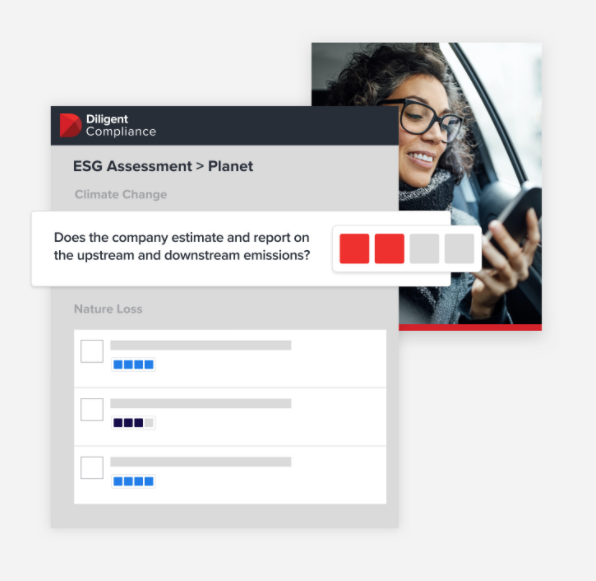Climate is a complex, nuanced topic with significant implications for our businesses and our communities and the planet. -Betsy Atkins, board member with Wynn Resorts, Volvo Cars, and SL Green RealtyDiligent works with a network of nearly 700,000 board members and senior leaders from over 19,000 organizations. In 2020, even amid a global pandemic and its economic, societal, and geopolitical repercussions, one topic dominated when it came to governance. ''Last year, the most frequently asked question was: What should I be doing about ESG?'' said Betsy Atkins, a board member with Wynn Resorts, Volvo Cars, and SL Green Realty. In February, Atkins moderated an online discussion to explore a core part of ESG: climate. Speakers included leaders from around the world: His Royal Highness The Prince of Wales; Jenny Johnson, President and CEO, Franklin Templeton; Mike Wirth, Chairman and CEO, Chevron; Carmine Di Sibio, Global Chairman and CEO, EY. What main challenges have speakers been hearing and seeing, particularly as BlackRock CEO Larry Fink escalates the importance of climate change in his annual letter? How can companies-and the boards who provide vital oversight-begin to tackle these challenges?
Companies that are not quickly preparing themselves will see their businesses and valuations suffer. -Larry Fink, CEO, BlackRockHighlights follow in a two-article series about the challenges of climate, opportunities that can concurrently emerge from climate solutions, and how boards can successfully navigate both. This article, part one, examines challenges related to climate frameworks, disclosures and reporting, investor communications, and board oversight.
Challenge 1: So Many Frameworks
Most boards are familiar with the more prominent frameworks and metrics for climate, like the Sustainability Accountability Standards Board (SASB) standards, the Task Force for Climate-Related Financial Disclosures (TCFD), and the 10-point action plan of the Prince of Wales' Sustainable Markets Initiative. But these are just the tip of the slowly melting climate iceberg. Take a quick guess: How many standards, frameworks, and metrics currently address climate in our world today? 100? 500? Incredibly, over 2,000 laws, regulations, and policies exist worldwide related to climate. This number, and its exponential growth, is creating ''a perfect storm'' in Atkins' words. The good news: Much hoped for standardization is starting to happen. Wirth and Di Sibio have both been involved in efforts by the World Economic Forum and its International Business Council to create a new, consolidated set of ESG global standards, including standards for climate. It's a start. These new metrics have been making it easier for some firms to collect and track data, according to Di Sibio. However, the journey is far from over. ''This broad range of metrics and methodologies apply to so many different sectors that are so fundamentally different from one another,'' Wirth said. In short, ESG means different things to different industries and companies. Take, for example, the amount of carbon removal required to achieve carbon neutral or carbon negative status. This number is going to look very different for an energy company, a manufacturing firm, and a provider of technology services. Where the company does business will impact the frameworks it considers as well. In Europe, one of the frameworks boards should put on the agenda is the ''EU Taxonomy.'' This aims to provide a unified classification system for ''green'' and ''sustainable'' economic activities under the EU's sustainable finance regulations. The United States has rejoined the Paris Agreement, meaning that it may behoove companies operating here to put net-zero goals on their agenda, and keep the possibility of SEC and other disclosure requirements on the longer-term horizon. Broadly speaking, Europe leads the way and drives the rest of the world in climate regulation, with parts of Asia - specifically Hong Kong, Malaysia, and Singapore - following. As frameworks emerge, align, and vary across industry and geography, an important first step is education. ''Directors have to come up with a learning curve,'' Atkins said. ''We need to understand what carbon neutral is, what carbon negative is, and what the Paris Agreement and Scope One, Two, and Three emissions are. Then we can figure out what commitments to make, how much they will cost, and what the trade-offs are.'' Increasingly, she said, as ''climate is such a lightning-rod issue,'' this knowledge imperative also applies to private companies and financial players like endowments, sovereign funds, and private equity firms as well.Challenge 2: Reporting
Climate disclosures bring even more complications for companies and the boards that provide guidance and oversight. Raters, rankers, scorecards, and indices proliferate with differing levels of specificity and ambiguity, with little alignment across them, and evolving technical and data interface standards-spurring questions (and frustration) among governance professionals. In the area of carbon reduction, for example, what type of metrics should a company use for disclosures, and how often should they report? Should the firm provide data on a location level, on employee level, or some other level entirely? Specific to the Paris Agreement, does a company really need to master all three scope levels, and specific to Scope 2, how should they think about assessing and disclosing financial impact - and the accountability that comes with it? The devil truly is in the details. Fortunately, tactics, best practices, and lessons learned are emerging in this area. Chevron, for instance, uses web-based reporting to keep up with evolving and escalating disclosures. The company also has a firm grasp of Scope 1, 2, and 3 levels of reporting for the Paris Agreement, all of which apply to its operations. Scope, Wirth explained, is a matter of control:- Scope 1 involves direct emissions from operations a company owns or controls, like the greenhouse gas emissions resulting from power generation
- Scope 2 involves indirect emissions from the energy a company purchases, like the power to run its servers
- Scope 3 involves all other indirect emissions in business, like the products that are sold and used by consumers
We encourage clients to get ahead of the issue and start doing some disclosure before they absolutely have to. -Carmine Di Sibio, Global Chairman and CEO, EY
Challenge 3: Investor Communications
Investors are calling for more ESG disclosure and transparency, and climate is a big part of that. -Betsy AtkinsSince co-founder John Templeton's initial screening-out of ''sin stocks,'' Franklin Templeton has been a leader in socially responsible investing. Today it is among the world's largest ESG investors with over $1.4 trillion in assets under management. So what are investors like Franklin Templeton looking for in terms of climate information from companies and boards? ESG evaluations happen at many levels, Jenny Johnson explained. For some organizations, the decision is based on risk. If this is deemed acceptable, the firm may still may invest in a company that others might not like. Other investors consider potential outcomes and impact toward a specific ESG goal - for instance, they've created a pool of assets to support green energy or diversity and gender equality. Given the disparate and evolving nature of climate frameworks, and in light of the marked differences across industries on what to measure and what success looks like, engagement between investment teams and corporate management is critical, Johnson said. She walked through the process at Franklin Templeton. Each investment team has their own process for making decisions, and evaluations in different sectors are going to be looking at very different things. In Europe, for example, standards and disclosures will vary based on EU Taxonomy's specifically labeled categories of investment. Across jurisdictions and sectors, teams want to see intentionality, improvements, and informed answers to questions about risk, Johnson said. And the overall goal remains the same: ''Show me you've made these kind of improvements and that there is an evolution happening here.'' Wirth weighed in from the corporate perspective: ''[Investors are] looking for a competitive edge and they're looking to use the methodology that they think satisfies the investment thesis that [people] want to invest into and they may qualify and assess these things differently across different teams.'' Companies and boards can also look forward to more scrutiny from financial players in the evolving climate landscape. ''I think you'll be seeing more and more impact funds coming out specifically targeted to climate change efforts,'' Johnson said, citing efforts like the EU's plan to sell $267 billion worth of green bonds as part of its pandemic recovery plan.
Challenge 4: Board Oversight
Underpinning all of these complexities is the biggest challenge of all: incorporating climate into board discussions and decisions. Is the board asking the right questions and having the right conversations - with management and among themselves - to provide the sound, forward-looking guidance and oversight such a complex, critical topic demands?You have to be thinking about it as you're running your business. These are important questions for boards to be able to understand and to ask management. Jenny Johnson, President and CEO, Franklin TempletonOur speakers advised that boards manage climate issues as they would any area of risk: operational, financial, security, geopolitical, and beyond. From physical risk because of the weather to financial risk because of concern over the strength of assets, climate plays a role. For Wirth at Chevron, such risk management is a regular part of business and a given in his industry. ''Our board and our management team are really focused on understanding how to identify risks and make sure we have appropriate safeguards in place to mitigate them. The risks associated with climate - policy risks, political risk, physical risks - are things that we take very, very seriously.'' ''Manage all of these risks from a holistic standpoint point and with discipline, rigor, and accountability,'' he advised. Johnson cautioned boards to think about long-term risk. Solar panels are one example. What happens 20 years later when they reach the end of their useful life? Will the solar panel company pay to have someone come out to a home or building and take them down for recycling? Or what about resetting parts of the battery in an electronic vehicle? ''It's complicated. Anybody running a business or being on a board needs to see through and understand what could be the next wave,'' Johnson said. ''What are the liabilities that we're not thinking about today as we are trying to grow that could become long-tail risks?'' In the short- and long-term, risk management leads to another vital area of board responsibility: oversight. For example, with carbon offsets, how do you make sure that the carbon is actually offset and that the money is not used in other ways? The frameworks, disclosures, and communications mentioned earlier are key, as they contribute to tracking and accountability. ''You only get an improvement on the things that you track,'' Johnson said. ''And I think you become accountable when you go public with it.'' To achieve this tracking and accountability, boards have begun integrating climate into their roles, responsibilities, and processes. ''Many boards now, including ours, have a chief sustainability officer,'' Di Sibio said. ''Their job is to make sure that the company is on the right path around sustainability.'' He noted that chief sustainability officers often report directly to the CEO and that many companies in Europe fill this role with one of their most senior people. Speakers anticipated that more firms and corporate boards will have a dedicated committee on climate issues or add these issues to an existing committee's responsibilities. Wirth shared highlights from Chevron's committees:
- A public policy and sustainability committee focuses on climate policy and trends
- The compensation committee reinforces policy through accountability and metrics
- The nominating governance committee makes sure the directors have the proper background experience and skills to add value
- The audit committee handles financial disclosures and risk management practices as they relate to climate issues
Learn More About Diligent's ESG Solutions
 Learn how Diligent's ESG solutions are helping companies operationalize ESG principles, track progress against standards, and monitor stakeholder sentiment.
Learn how Diligent's ESG solutions are helping companies operationalize ESG principles, track progress against standards, and monitor stakeholder sentiment.

Media Highlights
Environmental, social and governance (ESG) issues have become more complex and multifaceted than ever before. At the same time, ESG continues to ascend on board and leadership agendas.
In this buyer’s guide, we explore what a market-leading ESG solution should look like and highlight the key areas organisations should be prioritising as they embark on their search.




